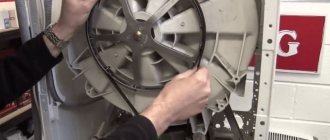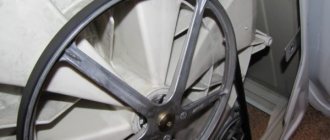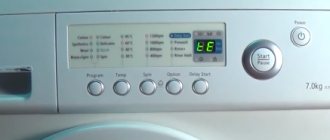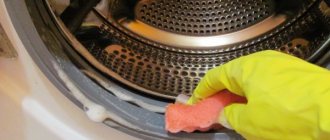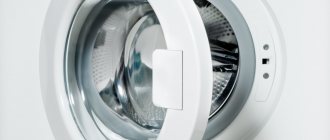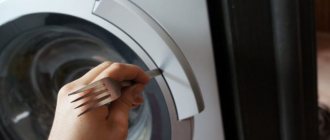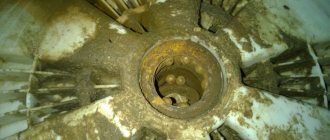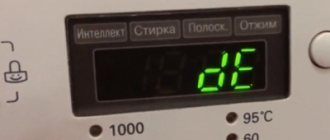When to call a specialist?
Three situations are possible:
- A thin object, such as a bra wire, got stuck in one of the holes in the drum. To remove it, pinch the accessible end with pliers and gently pull, being careful not to break it. Of course, such a task can be completed without a specialist.
- The loss is not visible, but you are sure it is in the typewriter. Small things like a chain, screw, or coin may end up in the drain filter. It’s not difficult to get them yourself - you don’t need a master either.
- If you hear a clanging noise as the machine is running, as if metal is rubbing against metal, a foreign object may have gotten underneath the drum. At this point you need to call a specialist. A metallic sound may also indicate wear or malfunction of a part. It is difficult to diagnose a breakdown without the help of a specialist.
How to remove a pit through the drain system
If the bone is plastic, it breaks easily. Because of this and because of its low weight, its parts do not linger in the drum or heating element, but slip further into the drain system of the machine. They should be removed according to one of the instructions described below, according to their location.
How to remove through the filter
The filter should be cleaned regularly. This is where all the debris and small objects that slip through the perforations of the drum fall. Parts of a broken bone can also be found here. Cleaning the filter occurs in the following order:
- Open the filter hatch. It is located at the bottom front of the device. You can open it by pressing the latch or prying it with a screwdriver.
- Prepare a rag or container to drain the water. Since the hatch is at the very bottom of the car, sometimes it is more convenient to tilt it backwards.
- Holding the special tabs, unscrew the filter. Get it.
- Carefully examine the filter and the hole where it is placed. The bone can be found in both places.
- Rinse the filter under the tap.
- Clear the hole of accumulated debris. Wipe it with a cloth.
- Insert the filter and screw it on. Close the hatch.
Reach through the drain pipe
You should look for laundry accessories in the drain pipe if they are not found in the drum or filter, and also provided that the machine does not make any extraneous noise during operation. The set of measures is somewhat different for different types of devices. Standard type washing machines that are not equipped with housing protection against leaks are best disassembled according to the following instructions:
- Place the equipment on its side.
- Unscrew the bottom fasteners or unclip the latches. Remove the lower housing.
- Unscrew the fastener on the ring or loosen the bolt on the clamp.
- Remove the pipe.
- Inspect the drain hole and the visible inside of the machine. To do this, it is better to use a flashlight. Sometimes the bone may fall out on its own if it gets stuck at the exit.
- Insert the pipe and tighten the fasteners.
- Place the bottom. Turn the equipment over.
If the washer is equipped with spill protection, it is not recommended to remove the bottom. To get to the pipe through the bottom, you will need to remove the protective element, which requires some experience. Therefore, it is more convenient to get to the pipe through the rear wall. Then you need to look for the stuck part by touch, as far as your fingers can get through. It is difficult to look inside, because... the hole is quite narrow. Finding a bone can be very difficult if it is not located near the attachment point of the pipe.
If a bone gets stuck in the pump
Evidence that a bone has entered the pump is a strong buzzing or grinding sound when it is turned on. It is also worth paying attention to the drainage system. If the pump is faulty, water may not drain well or not be pumped out at all.
Important:
If you hear an unusual noise when pumping or draining water, you need to stop using the machine. If a foreign object gets into the pump, it may burn out.
You need to deal with the problem as soon as possible. To remove the bone from the pumping equipment, you will need to open it. Its location differs for different models:
- The location behind the filter is found in Ariston, Ardo, Veko, Indesit, Samsung, Candy, Whirpool, LG. It is easier to inspect the pump through the bottom, using the instructions described above.
- Location on the rear wall of Electrolux and Zanussi. It is better to disassemble through it.
- In the central part, closer to the top, AEG, Bosch, Siemens. To get to the pump, you need to remove the cover and front wall. You need to remove the dispenser and unfasten the hatch cuff. You should not disassemble such machines yourself, so as not to damage the device. Owners of such devices should immediately contact a professional.
The installation method and internal structure of the pumps are identical. To remove the bone from the pump, you need to:
- Pull out the connector to turn off the power.
- Prepare a basin and a rag, since during disassembly the water remaining in the pump will flow out.
- Unscrew the fasteners that secure the equipment to the housing.
- Loosen the clamps, remove the inlet and drain hoses.
- Unscrew the snail.
- Remove the impeller from the housing. The bone often gets stuck between its blades or is pressed against the body inside, which can be seen after removing the impeller.
- Inspect the impeller. If it is damaged, the pump will not be able to work productively, in particular, drain water. The entire pump will need to be replaced.
- If there is no damage, the impeller must be replaced and the pump reassembled.
Before fully using the washing machine, it is recommended to first check the operation of the pump unit. To do this, you need to run a quick wash and observe the operation of the machine in order to detect a leak in a timely manner. If the test occurs with the case not completely closed, you cannot touch the internal parts until the wash is completed.
How do they get there?
There are three ways for foreign objects to get into the machine:
- Every little thing falls into the drum from clothes sent for washing. If you just get lazy or forget to check your pockets, a problem is just around the corner. It’s not so bad if the dropped item gets damaged, and it’s much worse if the equipment gets damaged. The most common “clients” of the drum are money, jewelry, and fasteners. It happens that more important things - a phone or a passport - are accidentally erased.
- During rotation, beads, buttons, and other accessories may come off from clothing. Also, during the washing process, solid elements of bras may fall out.
- "Force Majeure". If small children or pets have access to the machine, they can easily put some toy or any other thing inside. By the way, foreign bodies can enter not only through the hatch, but also through the powder cuvette.
Consequences of clogging
Clogging household appliances with a foreign object does not bode well. Very often, such blockages cause obstruction of the drain pipe and lead to the fact that the apartment may be flooded. In addition, individual parts, such as a drum, may be damaged if the sock prevents it from functioning normally.
Even if you are not sure that you started to wash exactly 2 socks, it is better to play it safe and make sure that it did not get stuck inside. Caution will help you maintain the integrity and performance of your expensive equipment.
Express extraction
As soon as you realize that something unnecessary has gotten into the machine, take action immediately. Cancel a running program. This is done like this:
- Press the “start/pause” button of the selected program - the machine will stop washing.
- Press the same button again and hold for five seconds.
- Wait until the pump pumps out water and the machine turns off.
There are machines that do not have automatic draining. In this case, you will have to drain the water through an emergency drain or through a drain filter. This must be done to unlock the hatch door. Afterwards, the door is opened and the foreign body trapped inside is removed.
How to avoid problems?
To prevent breakdowns and not resort to expensive repairs, it will be useful to listen to constructive recommendations:
- Make it a rule: before washing, you should turn out all the pockets of your clothes.
- Sew on poorly holding buttons and small accessories in a timely manner.
- Look inside the machine and into the powder drawer before loading clothes.
- Buy laundry bags. They come in a variety of shapes and sizes, and can be used to wash everything from socks to down jackets. There are even special containers for washing bras. You can also wash sneakers and textile shoes in bags. Thanks to such useful, unpretentious devices, you will maintain the attractiveness of things and protect your washing machine from troubles.
Video “How to remove a foreign object”:
By following basic rules, you can avoid many problems and losses. It’s good if inexpensive small things just got into the tank or got stuck - with a little fiddling, you can get it out. But if a sharp foreign body disrupts the integrity of the tank, serious and expensive repairs will be required.
How to remove small items from the washing machine?
If you are sure that the source of the noise during rotation is something foreign, you can try to remove it yourself. Provided that you have basic skills in handling equipment and tools. The wall of front machines is removed; depending on the model, the front or rear wall is removed. Before disassembling the unit, familiarize yourself with the diagram of this process. For example, let's look at the most common option - you need to remove the thing by first removing the top cover and back wall:
- Drain the water and disconnect the machine from the power supply.
- Unscrew the bolts securing the top cover - they are located on the rear wall - and remove the cover.
- Unscrew the screws that secure the back wall and remove it. At this stage, you can detect soft objects - for example, paper, a belt or a sock. Once outside the drum, they are wound onto the heating element. But you shouldn’t stop there, because if you hear a noise, you need to look for a solid body that could have produced it. So let's move on.
- Take out the heating element (heating element). To do this, disconnect the wiring that goes to it and unscrew the fastening nut. The heating element can be removed by hooking it with a screwdriver.
- Illuminate the hole formed after removing the heating element with a flashlight. The debris that is there needs to be removed. Small things often get caught in the gap between the tank and the drum. To make sure there is nothing else, rotate the drum - if a foreign element is stuck, it will fall out during movement.
- Build a wire hook. The length and configuration are selected taking into account the location of the stuck item. Take out the loss by picking it up with a hook.
- If you have already removed the heating element, clean it of deposits. When returning it to its place, make sure it fits exactly there. Tighten the nut and connect the wires.
- Reassemble the machine parts in reverse order. Tighten all fasteners.
To avoid mistakes when connecting the wires, take a photo or sketch first.
It happens that the loss gets stuck so much that the drum jams. Then disassembling the tank is inevitable. Removing the “lost” is comparable in complexity to replacing a bearing. But to remove anything from a non-separable tank, you will have to saw its body. This task takes several hours and requires special skills and tools. Usually it is entrusted to a specialist.
Important! Even soft objects, a scarf or a sock that gets inside the machine can block the drain pump or prevent it from rotating.
Extraction
You can remove a bra wire at home by disassembling an automatic machine. Before performing any of the above methods, you need to drain the water and disconnect the washing machine from the power source.
Through the drain
The lost piece of underwear may be in the drainage system. It can be obtained in 3 ways:
- Through a filter. You need to remove the narrow panel at the bottom of the front wall of the machine. Usually on the left side there is a hatch behind which there is a filter. You need to tilt the machine back, place a rag under the bottom and press on the lid that closes the mechanism. Next, the filter is removed. The bone can be located in it, or in the pump located immediately behind it (visible in the resulting hole). After removing it, the part is screwed back in and covered with a panel.
- Through the pipe. The machine must be placed on its side and the bottom cover, if present, must be removed. There is a pipe between the tank and the pump; you need to loosen the fastening clamp on it and remove the part. If the bone does not fall out on its own, you should shine a flashlight into the hole and look for it between the heating element and the tank. After finding the lost part, you need to put the pipe back, fasten the clamp and bottom panel, and then place the washing machine vertically.
- Through the pump. If the machine does not drain water well or makes a loud noise during the process, it can be assumed that a part has gotten into the pump, although this is a rare occurrence. Before you remove the bra wire from the washing machine drum through the pump, you need to find out where it is located in this model.
In most machines, the pump is located behind the drain system filter. You can detect it by following the steps provided in method 1. In Electrolux and Zanussi brand machines, the pump is located closer to the back panel, so you need to unscrew it to gain access to the mechanism.
In German models, to find the pump, you need to remove the top and front covers, and also remove a number of other elements. This is difficult to do without experience, so it is better to turn to specialists.
After determining the location of the mechanism, you need to place containers to collect water and place rags under the washer. Next, disconnect the power connector, unscrew the fastening screws, and detach the drain hose and pipe that come out of the pump. After this, unscrew the volute from the housing, remove the engine, inspect the casing and parts for the presence of a bone.
If there is no damage to the pump, then it can be assembled and installed in place; if there is, buy and secure a new mechanism.
Through a tubular electric heater
Most often, a stuck element can be found directly under the electric heater, or between its tubes. The extraction method is suitable for machines with horizontal loading, in which the heating element is located at the rear. To use it, you must complete the following steps:
- Drain the water and turn off the electricity supply.
- Turn the washer back towards you.
- Remove the back panel by unscrewing the screws.
- Locate the large wheel (drum pulley).
- Directly under this mechanism, find contacts with wires (the visible part of the tubular electric heater).
- Remove the terminals from the 2 wires.
- Loosen the nut on the stud, which secures wire 3, without removing it completely (only until it reaches the back line of the stud).
- Press the pin, pressing it inside the electric heater to the level of the nut.
- Using your hands, rock the heating element (the mechanism itself, do not pull the wires) little by little and pull it out.
- Find a bone between the heater tubes. If it is not there, then look through the hole formed after removal into the tank, it should be there.
- Use a hook or knitting needle to pick up and pull out the find.
- Inspect the heating element for damage and dents. Insert the mechanism back if they are missing, or replace it with a new one if deformations are detected.
- Tighten the nut and connect the terminals.
- Without screwing the back cover, run a test wash. If no water leaks are detected and the washing machine is working normally, then screw the panel into place.
Removing a foreign object without disassembling the device
If a bone from a bra gets into the drum, you can get it out without disassembling the washing machine. There are several ways to do this:
- If you manage to feel the tip of the bone on the surface of the drum, you should, armed with tweezers or pliers, pull it and remove it.
- If a foreign object gets inside the washing machine, you need to bend the rubber seal of the front panel hatch. After this, you should push the drum a little to the side, feel for the metal part of the bra with the hook, hook it and pull it out.
- It is necessary to shine a light through the perforation; if the bone is visible, then you need to make a hook with bends at both ends from wire or a large paper clip. One turn should be secured to a finger so that the structure does not fall through the grate; with the second, try to catch an object that has fallen into the tank.
After fixing the bone with a hook, you need to try to lift it vertically and get into one of the holes in the perforation. It is better to ask an assistant to rotate the drum a little to achieve a greater likelihood of hitting the hole. It is permissible to use thread or thin rope instead of wire. You need to make a tightening loop at one end, hook the bone on it, and pull out the lace.
Some models of top-loading machines have a special hatch for removing seeds and similar things. It is necessary to close the washer flap, turn the drum halfway, then open it again and return the mechanism to its place. Next, through the hatch, which is located opposite the doors, get the lost item.
Bra in the washing machine
What's the harm?
If a bra wire gets into the machine, and the user ignores this fact, the following problems may occur:
- Mechanical damage to device parts. At high rotation speeds, the solid element acquires enormous force - it can easily pierce the walls of the drum and disrupt the integrity of the tank or heating element. We will have to repair damaged elements and fight the flood.
- Damage to the rubber seal around the hatch.
- Rotation lock.
- Even if it doesn’t interfere, a bone stuck somewhere in the depths will begin to rust over time and begin to stain clothes that are washed in the machine.
You can tell if a bone is stuck by hearing extraneous sounds. You can remove it in the same way as any other items - by disassembling the device. We have provided instructions above.
How to get it?
The extraction process depends not only on the location of the item, but also on the material from which it is made. Bra inserts are made of plastic and metal. Iron ones are much more dangerous - they can seriously harm the machine. But they can be removed with a magnet without resorting to disassembling the device. To get the plastic analogue, disassembly is required.
Extraction through heating element
The method is suitable for models with a heating element located at the rear. Sequencing:
- Disconnect the device from the power supply - remove the plug from the socket.
- Turn the device over so that it is convenient to enter from behind.
- It’s good if there is a service hatch, you can work through it. If it is not there, remove the wall and remove the heating element, disconnecting the wires. Then they take out the “lost one”.
What if through the drain?
If the bra element is stuck in the pipe, it is removed from below. The order is:
- Disconnection from the power supply;
- Installing the device in a convenient position;
- Removing the container for washing powder;
- Turning the machine over onto the side wall;
- Unscrewing the screws and removing the clamps securing the bottom of the device - this way you can get to the drain pipe;
- Removing the pipe;
- Removing the bone. Cleaning and installing the pipe. Machine assembly.
No disassembly
If the bone is at the bottom of the tank, you can do without disassembling it. A flashlight and something thin, for example, a knitting needle or wire, will be available as auxiliary tools. After establishing the exact location of the loss, it is hooked with a hook made of wire/knitting needles. Moreover, there should be hooks at both ends. The object being removed is picked up first. The other one will come in handy in case of the fate that befell the bra wire. Having inserted the hook into the hole, pry the thing up and slowly scroll it until the bra insert stands vertically. As soon as the end of the bone gets into the hole, the pliers go into action.
How to remove it from the machine?
After discovering that a bone is missing, even if the machine continues to work properly, it should be removed immediately. If this is not done, the following consequences are possible:
- the appearance of yellow stains on linen, as a metal part rusts and stains things when exposed to water;
- damage to the tank wall;
- violation of the tightness of the rubber cuff around the hatch if a metal fragment sticks into it;
- damage to the heating element if a piece of underwear gets stuck between it and the drum during rotation;
- leakage due to holes in the tank or seal;
- breakdown of the entire washing machine.
If an object gets stuck under the drum of the washing machine, you can remove it yourself or contact a service center.
Finding the location of an item
Before you remove a foreign object from the machine drum, you need to find exactly where it is located. An item lost during washing can get stuck in the tank, drum, between them, as well as in parts of the drain system. To clarify the location, you need to do the following:
- Drain the water.
- Disconnect from the power source and remove all laundry.
- Carefully feel the surface of the drum; perhaps the bone has not yet had time to sink completely.
- If it is not found, then using a handheld or headlamp, shine it through the perforation at the bottom of the drum. A bone that has fallen into the tank will be visible through the holes.
- Rotate the drum slightly from side to side. A metal part stuck between the rotating mechanism and the tank often slows down movement in a certain area.
- In the case where it was not possible to detect the dropped element, we can conclude that it is in the drainage system.
Signs of a foreign object getting into the washing machine
The most common signs of a bone getting into the washing machine drum:
- shaking;
- scratching, scrolling, metallic knocking;
- sudden stop, leaks;
- problems with pumping and draining water.
Be wary if you do not find a metal part in clean washed laundry. It is very likely that it got into the drum and remained in it. By following the instructions on how to remove a bone from a washing machine, many users successfully solve the problem themselves.
A bone from a bra got into the drum of the washing machine - what should I do?
A washing machine is an indispensable assistant when washing everyday clothes, outerwear, bed linen and even women's underwear. However, if the operating rules of the device are violated, namely when washing bras without using a special laundry bag, the bone may get into the washing machine. This article will help you solve the problem yourself, but if you cannot do without disassembling the machine, it is better to contact a service center that specializes exclusively in repairing such household appliances.
A bone has gotten into your washing machine and you don’t know how to get it out? Contact us by phone or leave a request on the website. Remember, if a foreign body gets stuck in one of the elements of the washing machine, then it is extremely undesirable to use the household appliance until it is removed, because this can cause serious harm to your home helper. offers urgent repair of a washing machine at home at a time convenient for customers: from 7:00 to 23:00 daily, including weekends and holidays. Our services are inexpensive and available to all residents of Moscow and the Moscow region.
Features of washing women's underwear
Wherever a bone gets in the washing machine, it can be removed using any of the following methods, but the problem can be avoided if you follow certain rules and know the safety precautions: It is
better to wash bras by hand, not in a machine. After all, in this way you will avoid problems with a stuck bone, and the item of women's clothing will remain in its original form for a long time without deformation of the cups.
Use special zippered laundry bags. If you don’t want to spend money on buying bags, then a regular pillowcase with a zipper will do just fine.
Even before washing, you should make sure that the bra is not torn, especially in the area where the edge of the wire comes into contact with the fabric.
Using a container for bras, you don’t have to worry about the foam rubber getting wrinkled.
Through the “socket” for the heater
On washing machines in which the heater is located on the back side under the tub, you can remove the stuck object through the hole in the heating element. Moreover, it is here that the “lost ones” cling, clinging to the hot spiral. You cannot leave a rope or other small thing here - the machine will stop heating at full strength, and the element itself will quickly burn out.
Before any repair operations, make sure that the washing machine is disconnected from the water supply and electricity supply!
To remove the cord from the tank, you will first have to remove the heating element. We are guided by the following instructions:
- turn off the power to the washing machine;
- turn off the water supply tap;
- turn the machine with the back panel towards you;
- remove the “backdrop” by unscrewing the bolts holding it;
- find the heating element “chip” under the tank;
- release the heater from the connected wiring;
- loosen the central nut without unscrewing completely;
- press the rod inward so that it is “even” with the nut;
- use a rocking motion to remove the heating element from the “socket” (do not pull the heater by the connected wires - this can damage the power circuit);
- treat the heating element with WD-40 cleaner if the heating element does not work.
As a rule, the lace is pulled out along with the heating element, since the rope clings to the spiral. If the heater is “clean”, then you need to shine a flashlight through the hole and find the “lost” one. The item is obtained using an inserted hand, a screwdriver or a bent wire.
After “releasing” the cord, it is recommended to carefully inspect the heater for defects. It is possible that even short-term contact with a foreign object damaged the heating element. If there is noticeable damage, cracks or chips on the surface of the element, it must be replaced. Ideally, even visually the entire device should be checked with a multimeter. A replacement replacement is selected based on the serial number of the washing machine.
After all the manipulations, the washing machine needs to be assembled. We follow the instructions described, only in reverse order. At the “finish”, we make sure to carry out a test wash, checking the correct installation of the heating element, drain pipe or garbage filter. Let’s not forget about “working on mistakes”: from now on, it’s better to wash small items in special protective bags.
Interesting:
- Washing laces in the washing machine
- Washing white socks in the washing machine
- Washing laces in the washing machine
- Which LG washing machine to choose
- How to wash clothes for newborns
- A foreign object got into the washing machine - how to get it out?
Reader comments
- Share your opinion - leave a comment

